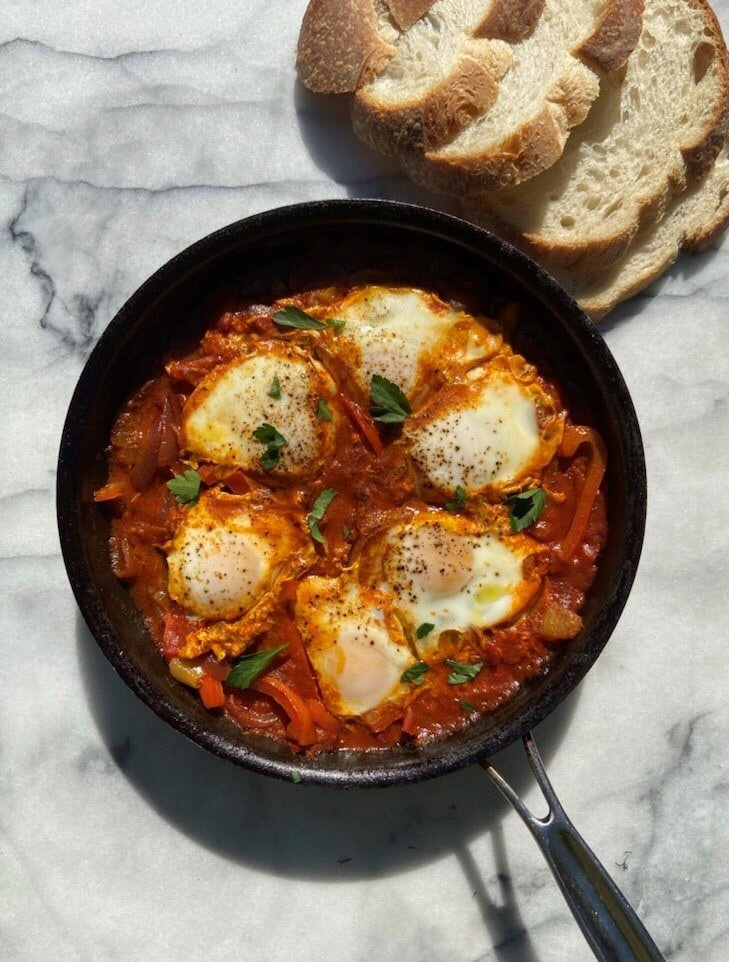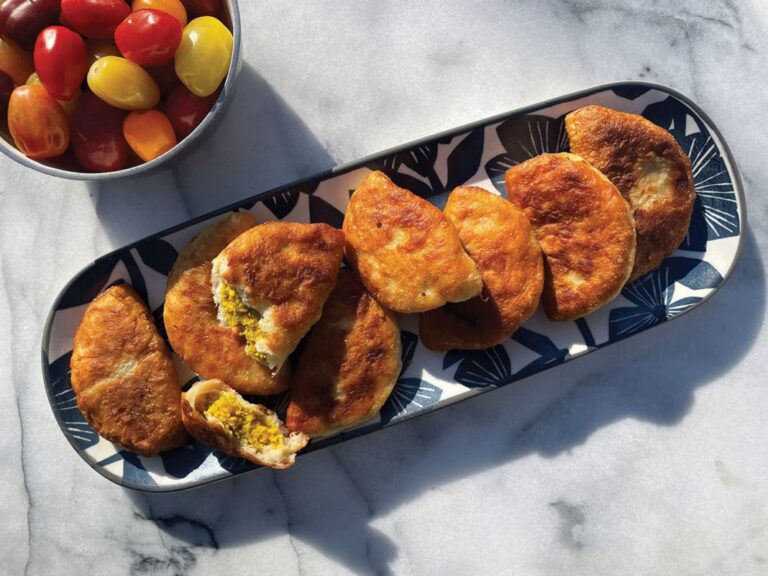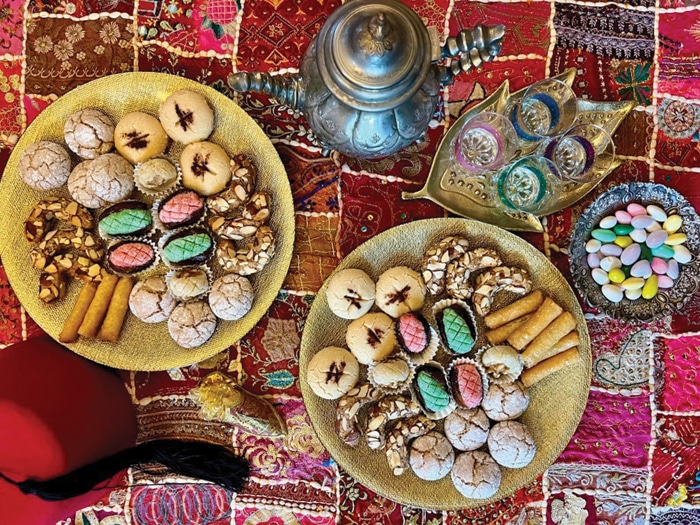A Heavenly Sephardic Bread
Called pan de siete cielos (seven heavens bread) it is a traditional Sephardic recipe that barely survived the Spanish Inquisition.

Last week, in anticipation of Shavuot, Rachel and I hosted an amazing community baking class at Kahal Joseph Congregation in Westwood. It is always a pleasure for us to be at Kahal because it’s where we hung out with all our friends at events run by the Sephardic Educational Center when we were young and it’s where our boys played and learned to pray. (Did I mention that my baby brother Rabbi Natan Halevy is the spiritual leader?)
Our dear friends Yvette Dabby, Orly Kattan and Elizabeth Levi of Kahal’s Sisterhood made the most incredible dough for cheese sambusak (recipe can be found at JewishJournal.com). We demonstrated how to make it. Then the bakers got to roll the dough, fill it with a delicious cheese filling and take their sambusak jib’n home to bake. (We got rave reviews from the tasters.)
Our Instagram bestie Sivan, of @sivanskitchen made a star appearance, showing everyone how to make her no-bake Israeli cheesecake. Made with a mix of heavy whipping cream, sour cream, Israeli vanilla pudding and lemon rind and a delicious shortbread crumb, it’s sooo good! (You can find the recipe on her Instagram @sivanskitchen.)
—Sharon
These classes are always a joy for Sharon and me because they are a special opportunity to socialize with our friends and to meet new people. We love the way everyone interacts and shares with each other and we love the feedback from our cooking community.
We always try to teach recipes that people will actually include in their kitchen repertoire. Perhaps a nostalgic recipe that they grew up with but never felt they were capable of making. Perhaps a recipe that is frm a different culture but that can be adapted for our American Jewish palate.
I decided to share a special recipe that I have been making for Shavuot. Called pan de siete cielos (seven heavens bread) it is a traditional Sephardic recipe that barely survived the Spanish Inquisition. After the Expulsion, the tradition of this bread was maintained in a few Sephardic communities. I thought I was pretty knowledgeable about Sephardic recipes, but I was blown away when I learned about this bread from Hélène Jawhara Piñer, who includes the history and recipe in her scholarly cookbook, “Sephardi.” Hélène stuffs her dough with cheese, which is incredibly delicious.
Nicholas Stavroulakis, the former director of the Jewish Museum of Greece, wrote a comprehensive work, “The Cookbook of the Jews of Greece,” and he obtained his recipe by interviewing Holocaust survivors from the once thriving Jewish community of Salonica. Truthfully, Moroccans don’t do dairy on Shavuot, but since marrying Neil, I’ve taken on the dairy tradition and I love it. For this bread, I took my sweet challah recipe and substituted one cup of water with a cup of whole milk. Milk makes the bread fluffier. Of course, if you are making the bread as a table centerpiece for a meat meal on Shabbat, then stick to your basic challah recipe or use my recipe with water.
This beautiful milk dough bread is a work of edible art and a symbolic tableau of the Shavuot story. The central element of the bread is a ball of dough depicting Mount Sinai, where the Israelites received the Torah. Then there are seven ropes in ascending layers placed around the center. The number seven recurs throughout Judaism. The six days of creation and the seventh day of rest. The seventh year of Shmita, where the land of Israel rests. Seven cycles of seven years for the Jubilee year. And of course, the seven weeks of counting the Omer between Passover and Shavuot.
The bread is then decorated with symbols, which can be religious or folkloric. This is where you can be creative (and maybe even let your kids get in on the fun). I made two tablets to represent the Ten Commandments. A hamsa, mostly for good luck, but also because the number five represents the Five Books of Moses. A fish, a symbol of fertility and good luck. A bird as a symbol of peace (the dove brought back an olive branch to Noah on the Ark).
A ladder is an essential symbol for this bread because of Jacob’s dream of angels going up and down the ladder between heaven and earth, symbolizing the connection between the heavenly and the earthly spheres. I also added some pretty pink miniature dried roses to symbolize the flowers that decorated Mount Sinai.
I have taken on this bread tradition to honor the Sephardic people who once lived a beautiful life in Spain, but loved the Torah so much that they refused to convert under pain of death.
Wouldn’t it be wonderful to make this bread a family tradition? I have taken on this bread tradition to honor the Sephardic people who once lived a beautiful life in Spain, but loved the Torah so much that they refused to convert under pain of death. I will make this bread to honor the memories of the martyrs of the Holocaust who died “al kiddush Hashem” because they were Jewish. I will make this bread to create happy memories and a joyous table.
Wishing you and your family a festive (and delicious) Shavuot!
—Rachel
“El Pan de Siete Cielos,” or, “The Bread of the Seven Heavens”
1 1/2 cups water
2 tsp of active dry yeast
1 tsp sugar
8 cups of flour
1 cup of sugar
1 tap salt
1 cup milk
4 eggs
¼ cup honey
3/8 cup avocado oil
1 egg, divided, for egg wash
1. Combine dry yeast, warm water, and teaspoon of sugar in a bowl. Cover with a towel and set aside to proof for 10 minutes.
2. Combine the flour, sugar and salt. Then add the warm milk, eggs, honey, and oil. Add the proofed yeast and mix until all the ingredients are well incorporated.
3. Transfer the dough to a working surface and, either by hand or with a Bosch bread maker or Kitchen Aid mixer, knead the dough until it is smooth and elastic, adding more flour as needed.
4. Return the dough to a large bowl, cover with plastic wrap and a towel. Set aside to rise for 2 hours in a warm, draft-free spot.
5. Preheat the oven to 350°F.
Bread assembly:
1.Take 1/4 of the dough and set it aside. Divide the remaining dough into two parts. Set one of the halves aside. Cover this and the other quarter of the dough with a towel.
2. Divide the piece of dough you are working with into three pieces. Roll each into a 18-inch rope. and braid into a three-braid loaf. Coil the loaf into a spiral. Lay it on the center of a parchment paper-lined baking sheet. This is Mount Sinai.
3. Take the second large piece of dough and separate it into seven pieces varying in sizes. These are going to be the “Seven Heavens” seven strands. Start by rolling the smallest piece into a strand and coil around the “mount.” Continue adding, each strand will be larger than the previous one.
4. The remaining piece of dough will be used to make the symbols on top of the “Seven Heavens.” (Ten Commandments, Hamsa, fish, bird, Jacob’s ladder, stars, flowers. Get creative.)
5. Beat the yolk in a bowl and use a pastry brush to wash all the symbols. Add the egg white to the remaining yolk and beat. Brush all over the rope
6. Bake for approximately 30 minutes or until golden brown.in the center. ■
Sharon Gomperts and Rachel Emquies Sheff have been friends since high school. The Sephardic Spice Girls project has grown from their collaboration on events for the Sephardic Educational Center in Jerusalem. Follow them
on Instagram @sephardicspicegirls and on Facebook at Sephardic Spice SEC Food.







